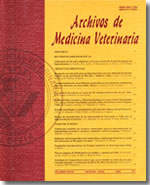Concentration of infectious pancreatic necrosis virus determined by combining tangential flow filtration with exclusion filtration
Main Article Content
Abstract
The infectious pancreatic necrosis virus, IPNV, is the etiological agent of a highly contagious disease that affects young salmon. The virus is mostly horizontally transmitted; therefore virus quantitation in water is mandatory for a proper sanitary management in the salmon industry as well as in the environment close to the hatcheries. To evaluate the water as a risk factor for IPNV infection in cultured or wild animals, it is necessary to titrate the virus with a suitable sensitivity. Therefore, a methodology that allows IPNV concentration to be determined in water using two kinds of ultrafiltration was developed. One, based on the tangential flow of the sample along the surface of a membrane, the other based on the retention of the viral particles at the surface of membranes with controlled pore diameter. Reagents and conditions were selected to reduce virus inactivation and/or virus binding to the filters. Finally, a protocol was developed that allows the concentration of IPNV in three orders of magnitude and with a total recovery of infectivity to be determined. This method can be performed in less than one day including virus titration using the fluorescent foci method.

